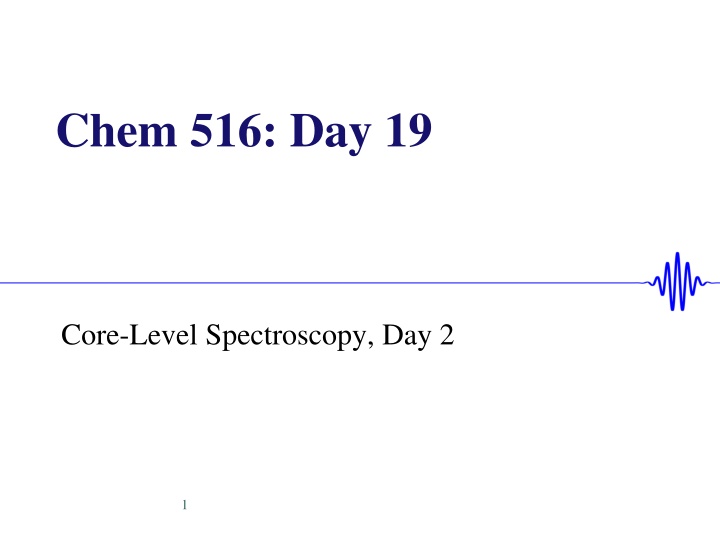
Core-Level Spectroscopy and Its Applications in Analysis
Explore the fundamentals of core-level spectroscopy through XPS and XAS, measuring energy levels and transitions in occupied orbitals. Learn about XANES regions, quadrupole strength, and pre-edge transitions to enhance your understanding of spectroscopic analysis techniques.
Download Presentation

Please find below an Image/Link to download the presentation.
The content on the website is provided AS IS for your information and personal use only. It may not be sold, licensed, or shared on other websites without obtaining consent from the author. If you encounter any issues during the download, it is possible that the publisher has removed the file from their server.
You are allowed to download the files provided on this website for personal or commercial use, subject to the condition that they are used lawfully. All files are the property of their respective owners.
The content on the website is provided AS IS for your information and personal use only. It may not be sold, licensed, or shared on other websites without obtaining consent from the author.
E N D
Presentation Transcript
Chem 516: Day 19 Core-Level Spectroscopy, Day 2 1
There are two general things measured with core-level spectroscopy Photoelectron spectroscopy (XPS) X-ray Absorption Spectroscopy (XAS) 2
XPS measures the energy of occupied orbitals Photoelectron spectroscopy (XPS) In the experiment, you use a fixed photon energy and measure the photoelectron energy: = ?.?.+?? ??????????? 1) Set this 2) Measure this 3) Calculate the Binding Energy as your answer 3
X-ray Absorption Spectroscopy (XAS) measures core-to-valence transitions X-ray Absorption Spectroscopy (XAS)
X-ray Absorption Spectroscopy measures core-to-valence transitions Mn 3p 10 O 1s, Mn 2p, Mn 2s 1 Mn 3s Absorbance 0.1 Mn 1s 0.01 0.001 100 1000 10000 Energy (eV) So far I m being confusing: I m showing the arrows go to the continuum, not to valence orbitals 5
A real XAS spectrum contains both core valence and core continuum Also known as Near Edge X- ray Absorption Fine Structure (NEXAFS) 6 Source: Wikipedia
XANES region is core electronic structure valence, gives M 4p M 3d S 1s ~-2400 eV M 1s Dipole-allowed transitions: L=1 (s p) Quadrupole-allowed transitions: L=2 (s d) 7
Strength of quadrupole tells you about distortion from Oh M 3d + (S 3p) + (M 4p) M 4p M 3d S 3p S 3p + (M 3d) M 1s The 4p mixing can only happen when it s not centrosymmetric 8
An extreme example of a strong pre-edge transition 9
Polarization of this gives orientation of active site Geometry of plastocyanin active site (CuII) 11 The hole must be in the dx2-y2, not dz2
You can also measure ligand K-edge M 3d + (S 3p) M 3d S 3p S 3p + (M 3d) S 1s M 1s Group question: How will energy and the intensity of this transition change as a function of Metal-Ligand covalency 12
Energy and strength both change as a function of covalency M 3d + (S 3p) M 3d S 3p S 3p + (M 3d) S 1s M 1s Prediction of higher intensity works, but prediction of higher energy doesn t (the ligand energies are too unpredictable) 13
EXAFS spectrum gives geometry 14 Source: Wikipedia
Photoelectron wave reflects off ligands ?? ??????????? ? = S h S Cu S S Remember from XPS: = ?.?.+?? ??????????? So as you scan the photon energy, at certain energies you get destructive interference (depends on the metal-ligand distance and geometry) 15
The workflow Subtract baseline, normalize 2? (? ?0) ? = Fourier Transform 16 Adv. Sci. 2019, 6, 1802126
You need to compare the PDF to models to see which fits best 17 Adv. Sci. 2019, 6, 1802126
Important points for EXAFS Gives geometry of non-crystalline samples Picks out geometry around a specific element Very high precision: (1.234 ), can be better than XRD Lots of steps in the analysis, easy to get wrong 19

